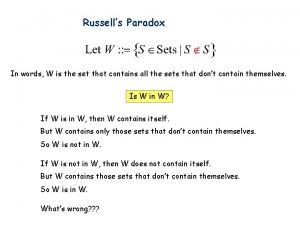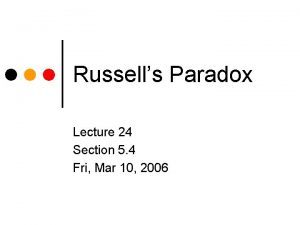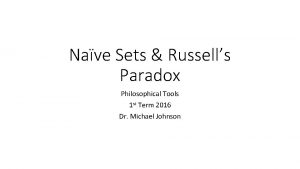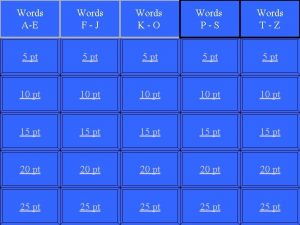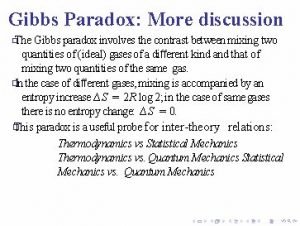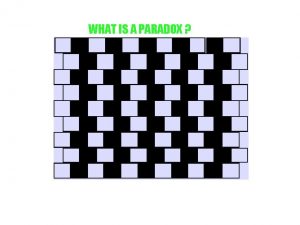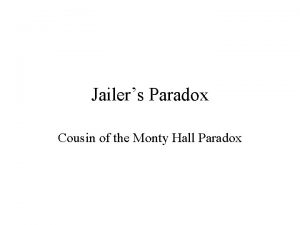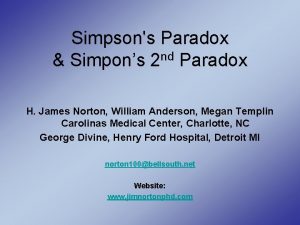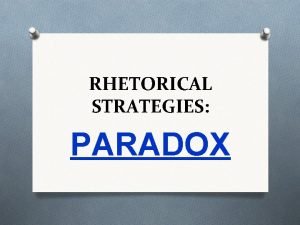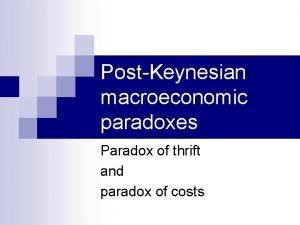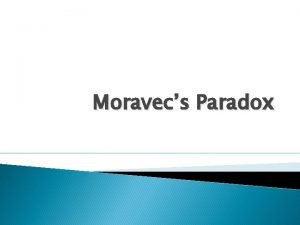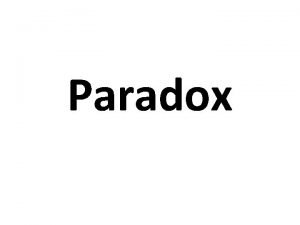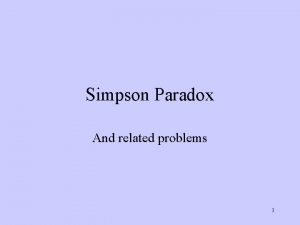Russells Paradox In words W is the set












![Functions domain = R codomain = R+-{0} codomain = R codomain = [0, 1] Functions domain = R codomain = R+-{0} codomain = R codomain = [0, 1]](https://slidetodoc.com/presentation_image_h2/3fbaeb960c6a6b8113bbe4d6d4644cd5/image-13.jpg)







- Slides: 20

Russell’s Paradox In words, W is the set that contains all the sets that don’t contain themselves. Is W in W? If W is in W, then W contains itself. But W contains only those sets that don’t contain themselves. So W is not in W. If W is not in W, then W does not contain itself. But W contains those sets that don’t contain themselves. So W is in W. What’s wrong? ? ?

Barber’s Paradox There is a male barber who shaves all those men, and only those men, who do not shave themselves. Does the barber shave himself? Suppose the barber shaves himself. But the barber only shaves those men who don’t shave themselves. Since the barber shaves himself, he does not shave himself. Suppose the barber does not shave himself. But the barber shaves those men who don’t shave themselves. Since the barber does not shave himself, he shaves himself. What’s wrong? ? ?

Solution to Russell’s Paradox A man either shaves himself or does not shave himself. A barber neither shaves himself nor not shaves himself. Perhaps such a barber does not exist? Actually that’s the way out of this paradox. Going back to the barber’s paradox, we conclude that W cannot be a set, because every set either contains itself or does not contain itself, but either case cannot happen for W. This paradox tells us that not everything we define is a set. Later on mathematicians define sets more carefully, e. g. using sets that we already know.

Halting Problem Now we study one of the most famous problems in computer science. The halting problem: Can we write a program which detects an infinite loop? We want a program H that given any program P and input I: H(P, I) returns “halt” if P will terminate given input I; H(P, I) returns “loop forever” if P will not terminate given input I. The halting problem: Does such a program H exist? Note that the program H can not just simulate the program P on input I; • if P halts on I, then H can return halt successfully; • but if P loops forever on I, then H will also loop forever.

Halting Problem We want a program H that given any program P and input I: H(P, I) returns “halt” if P will terminate given input I; H(P, I) returns “loop forever” if P will not terminate given input I. The halting problem: Does such a program H exist? Proof by contradiction: • Suppose, by way of contradiction, that H exists. • Both P and I are binary strings. • H should be able to determine if P will terminate given itself as the input. • That is, H(P, P) will either return “halt” or “loop forever”.

Halting Problem Inverter: Do the opposite to what H says. Construct an “inverter” program K which does the following given input P: • if H(P, P) returns “halt”, then K(P) will “loop forever” ; • if H(P, P) returns “loop forever”, then K(P) will “halt”. Loop forever Input for K(P) program P P: =P H(P, I) output If H(P, P)=halt H(P, P) If H(P, P)= loop forever I: =P Input for program H(P, I) K(P) halt

Halting Problem What happen if K is the input to K? What is K(K)? Loop forever Input for K(P) program P P: =P H(P, I) output If H(P, P)=halt H(P, P) If H(P, P)= loop forever I: =P Input for program H(P, I) K(P) halt

Halting Problem What happen if K is the input to K? What is K(K)? Case 1: Suppose H(K, K) says “halt”, that is H determines K(K) will “halt”. But then K(K) will “loop forever”, which is exactly the opposite to the answer. Loop forever Input for K(K) program K P: =K H(P, I) output If H(K, K)=halt H(K, K) If H(K, K)= loop forever I: =K Input for program H(P, I) K(K) halt

Halting Problem What happen if K is the input to K? What is K(K)? Case 2: Suppose H(K, K) says “loop forever”, that is H determines K(K) will “loop”, But then K(K) will “halt”, which is exactly the opposite to the answer. Loop forever Input for K(K) program K P: =K H(P, I) output If H(K, K)=halt H(K, K) If H(K, K)= loop forever I: =K Input for program H(P, I) K(K) halt

Halting Problem In either case, H outputs a wrong answer to K(K), this contradicts that such a program exists. Intuitively, no program can determine whether K halts when given input K, because the program K will do the opposite “after” you give an answer. The proof is due to Alan Turing (1936); you will see more of such arguments in a later class.

Remarks and References The argument used in the halting problem is called the “diagonalization” method. This was originally used by Cantor to prove that real numbers are “more” than Integers. This method has many other applications in theoretical computer science.

Functions Informally, a function f “maps” the element of an input set A to the elements of an output set B. More formally, we write to represent that f is a function from set A to set B, which associates an element with an element The domain (input) of f is A. The codomain (output) of f is B. Definition: For every input there is exactly one output.
![Functions domain R codomain R0 codomain R codomain 0 1 Functions domain = R codomain = R+-{0} codomain = R codomain = [0, 1]](https://slidetodoc.com/presentation_image_h2/3fbaeb960c6a6b8113bbe4d6d4644cd5/image-13.jpg)
Functions domain = R codomain = R+-{0} codomain = R codomain = [0, 1] domain = R+ codomain = R+

Functions f(S) = |S| domain = the set of all sets codomain = non-negative integers f(string) = length(string) domain = the set of all strings codomain = non-negative integers f(student-name) = student-ID not a function, since one input could have more than one output f(x) = is-prime(x) domain = positive integers codomain = {T, F}

Injections (One-to-One) is an injection iff no two inputs have the same output. f( ) = A ≤ 1 arrow in B |A| ≤ |B|

Surjections (Onto) is a surjection iff every output is possible. f( ) = 1 arrow in A B |A| ≥ |B|

Bijections is a bijection iff it is surjection and injection. f( ) = exactly one arrow in A B |A| = |B|

In-Class Exercises Function Domain Codomain f(x)=sin(x) Real f(x)=2 x Real f(x)=x 2 Reverse string Injective? Surjective ? Bijective? No No No Positive real Yes Yes Real Nonnegative real No Yes No Bit strings of length n Yes Yes Whether a function is injective, surjective, bijective depends on its domain and the codomain.

Inverse Sets A B Given an element y in B, the inverse set of y : = f-1(y) = {x in A | f(x) = y}. In words, this is the set of inputs that are mapped to y. More generally, for a subset Y of B, the inverse set of Y : = f-1(Y) = {x in A | f(x) in Y}.

Inverse Function Informally, an inverse function f-1 is to “undo” the operation of function f. f( ) = A exactly one arrow in B There is an inverse function f-1 for f if and only if f is a bijection.
 Total set awareness set consideration set
Total set awareness set consideration set Training set validation set test set
Training set validation set test set Bounded set vs centered set
Bounded set vs centered set Fucntions
Fucntions Crisp set vs fuzzy set
Crisp set vs fuzzy set Crisp set vs fuzzy set
Crisp set vs fuzzy set What is the overlap of data set 1 and data set 2?
What is the overlap of data set 1 and data set 2? Correspondence function examples
Correspondence function examples Hát kết hợp bộ gõ cơ thể
Hát kết hợp bộ gõ cơ thể Ng-html
Ng-html Bổ thể
Bổ thể Tỉ lệ cơ thể trẻ em
Tỉ lệ cơ thể trẻ em Voi kéo gỗ như thế nào
Voi kéo gỗ như thế nào Thang điểm glasgow
Thang điểm glasgow Chúa sống lại
Chúa sống lại Các môn thể thao bắt đầu bằng tiếng bóng
Các môn thể thao bắt đầu bằng tiếng bóng Thế nào là hệ số cao nhất
Thế nào là hệ số cao nhất Các châu lục và đại dương trên thế giới
Các châu lục và đại dương trên thế giới Công thức tính độ biến thiên đông lượng
Công thức tính độ biến thiên đông lượng Trời xanh đây là của chúng ta thể thơ
Trời xanh đây là của chúng ta thể thơ Cách giải mật thư tọa độ
Cách giải mật thư tọa độ





















